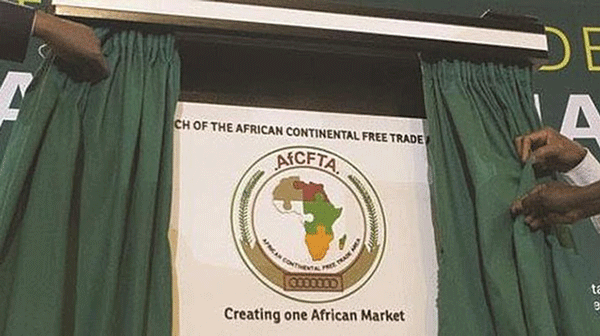
By Vince Musewe The African Continental Free Trade Area (AfCFTA) is an initiative by Africa’s heads of State to help boost intra-Africa trade and create a new developmental trajectory through regional integration and industrialisation. The establishment of AfCFTA, one of the flagship projects of Agenda 2063, represents a critical step towards the operationalisation of an integrated African market that is meant to culminate in the formation of an African economic community, in accordance with the Abuja treaty.
There is no doubt AfCFTA provides a unique opportunity for African countries in the region to competitively integrate into the global economy, reduce poverty and promote socio-economic transformation. The agreement will create the largest free trade area in the world measured by the number of countries participating. It will connect 1‚3 billion people across 55 countries with a combined gross domestic product (GDP) valued at US$3‚4 trillion.
The agreement will reduce tariffs among member countries and cover policy areas such as trade facilitation and services, regulatory measures such as sanitary standards and technical barriers to trade. It will also complement existing sub-regional economic communities and trade agreements in Africa by offering a continent-wide regulatory framework. It will regulate policy areas such as investment and intellectual property rights protection which are not covered in sub-regional agreements in Africa.
It is expected that AfCFTA will significantly boost African trade, particularly intra-regional trade in manufactured products. By 2035, the volume of total Africa’s exports are estimated to increase by almost 29%. Intra-continental exports would increase by more than 81%, while exports to non-African countries would rise by 19%. This would create new opportunities for African manufacturers, entrepreneurs and workers.
It is further estimated that by 2035, the effective implementation of the AfCFTA agreement would contribute to lifting an additional 30 million people from extreme poverty and 68 million people from moderate poverty. Real income gains from full implementation of the agreement could increase by 7%, or nearly US$450 billion.
There are a myriad of anticipated benefits from the successful implementation of AfCFTA. The major ones being catalysing the structural transformation of member countries from resource and low technology-based economies to more diversified knowledge-based economies in line with international developments especially the 4th industrial revolution. Added to this is the aim to encourage and hopefully increase both intra-African and external direct capital in-flows to African countries and to stimulate co-operation in other areas such as technology transfer, innovation, investment and continent-wide infrastructural development. This will also entail the need to eliminate some challenges associated with multiple and overlapping trade agreements between Africa and external countries or economic blocs.
The Economic and Distributional Effects report of 2020 by the World Bank gives projections of the potential macro-economic impacts of a successful AfCFTA.
The anticipated macro-economic impact to be felt direct by member States include lowering costs for consumers and producers, increasing the competitiveness of local production, seeing production shifts to the most competitive sectors which will lead to productivity gains, expansion of trade and faster economic growth, attracting more foreign direct investment and more importantly, an estimated increase in real incomes by 7% by 2035.
- Chamisa under fire over US$120K donation
- Mavhunga puts DeMbare into Chibuku quarterfinals
- Pension funds bet on Cabora Bassa oilfields
- Councils defy govt fire tender directive
Keep Reading
The volume of total exports is expected to increase with manufacturing exports gaining the most by 62%. Intra-Africa trade will increase by 110% and is expected to boost regional output by US$211 billion by 2035. We are bound to see an increase in the demand for skilled workers in manufacturing and sophisticated products. This would help stem the migration of Africa skills to Europe and elsewhere,
By 2035, total production on the continent would be almost US$212 billion higher, agricultural employment would increase in 60% of member countries, and wages for unskilled labour would grow faster. Sub-Saharan Africa’s employment is expected to grow from 437 million to more than 650 million, at an annual rate of increase of 2,7%. A growing manufacturing sector would provide new job opportunities, especially for youth and women, improve export sophistication across the continent by enabling more countries to integrate regional and global value chains and consequently increase the quality of exports.
Challenges faced
As with any initiative which involves multiple countries with multiple cultures, different political histories and at different stages of development, the successful implementation of AfCFTA faces a myriad of challenges which will require political will from member States and visionary leadership.
The primary challenges faced include; overall macro-economic stability within regional economies, currency and exchange rate management, attracting adequate long-term developmental capital to fund the infrastructure deficit ($40bn), across the board skills development, economic structural transformation to ensure inclusive growth and development, addressing non-tariff barriers, dealing more seriously with the scourge of corruption and meaningful political stability and reforms.
To ensure an equitable distribution of socio-economic costs and benefits across all 54 countries in Africa in a way that is politically acceptable to all, member States will have to establish appropriate institutional structures and mechanisms.
The building of productive capacities will be key in order to, accelerate structural transformation and the unleashing of the potential of the private sector, fostering domestic entrepreneurship. Domestic capital mobilisation will play an important part. Weak productive capacities and limited economic diversification, have constricted the range of intermediate and final goods that can be traded and this potentially inhibits the full development of regional value chains. Added to this has been high tariff-related trade costs, associated with the slow implementation of the tariff liberalisation schedules underpinning free trade agreements and high non-tariff-related trade costs hamper the competitiveness of firms and economies in Africa.
The Action Plan for Boosting Intra-African Trade of the African Union seeks to address the above issues to ensure that productive capacities within member States are boosted with the objective of creating regional and continental value chains/complementarity, to increase local production/trade in goods produced in Africa.
To achieve some of the objectives of the regional integration process in Africa, the effective operationalisation of the Abuja treaty requires the implementation of complementary strategic continental initiatives and programmes, such as:
- Comprehensive Africa Agriculture Development Programme for Infrastructure Development in Africa of the New Partnership for Africa’s Development;
- The action plan of the Accelerated Industrial Development for Africa initiative;
- The Action Plan for Boosting Intra-African Trade.
Historically, the growth of intra‐African trade has been constrained by a number of factors. These include: differences in trade regimes; restrictive customs procedures; administrative and technical barriers; limitations of productive capacity; inadequacies of trade‐related infrastructure, lack of comprehensive trade finance and trade information; lack of factor market integration; and inadequate focus on internal markets to help them grow and develop. In short this is what AfCFTA seeks to eliminate and its success will certainly contribute to integrated inclusive economic growth and transformation, wide-spread infrastructural development and overall regional development.











